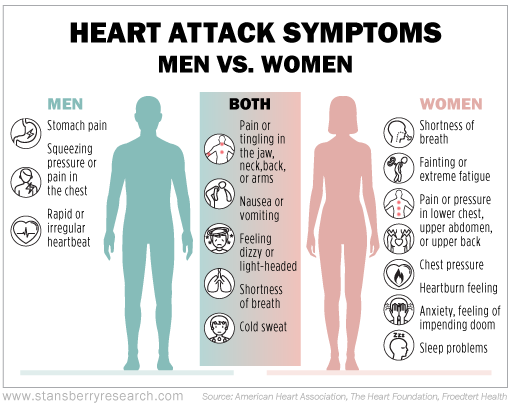The problem might start with a sleepless night...
Then it morphs into terrible indigestion, shortness of breath, and a pain in your back that won't quit. It persists over the next few days, so you go to the doctor.
He diagnoses you with an anxiety attack and sends you home with some anti-anxiety pills.
The next day, you die of a heart attack.
'This is not an unrealistic possibility for a woman in the U.S., where thousands of women with heart disease get the wrong diagnosis every year.
Heart disease is the No. 1 cause of death among women in the U.S. – killing one in five women. That's more than seven times the number of women who die from breast cancer.
It's also the No. 1 killer of men too, killing one in four men each year.
One of the most dangerous aspects of heart disease? Many folks don't show any symptoms prior to a heart attack. They may not even know they're at risk. In fact, a 2012 study from Circulation found that half of men who died suddenly from heart disease had no prior symptoms.
So that back pain or sudden dizziness might not make you think it's your heart. In fact, many people don't even know the symptoms of a heart attack. Or if they do, it's only the ones shown most often on TV – sharp pain in the chest that radiates down the left arm. But it's a lot more than that. And women experience different symptoms than men.
Getting help can immediately save lives. That's why it's so important for men and women to know the symptoms. As part of our Healthy Heart series this month, we're going to walk you through these symptoms and what to do...
Both men and women experience some of the same symptoms, the main one being shortness of breath. Men and women also feel pain or tingling in the jaw, neck, back, or arms. Typically, men feel arm pain more than women whereas women are more likely to have jaw and neck pain. Nausea, vomiting, and a cold sweat are all symptoms both sexes experience, though these aren't as common. And both may feel dizzy or lightheaded, but this occurs more often in women.
The biggest difference is in the chest. Men typically feel a squeezing feeling or sharp pain in their chest. But women typically don't feel this – they're more likely to feel pressure, like something is pressing on their chest.
But for women, it's not all that difficult to mistake a heart attack for something else... even for the person experiencing the heart attack might not know it's a heart attack.
The most common symptoms for women – fatigue, lightheadedness, sweating, anxiety, feeling of impending doom, and nausea – also fit symptoms that are seen with the flu, stress, indigestion, or even just anxiety. And because women often have higher rates of anxiety, they may receive the wrong diagnosis from their doctor.
A study in the journal Circulation: Cardiovascular Quality and Outcomes demonstrated that women with anxiety are 75% more likely to have reduced blood flow, which can lead to worse outcomes if they get heart disease. Men don't have this connection between anxiety and blood flow.
But bias persists in the medical community that women who experience these heart attack symptoms – and have few risk factors for heart disease – most likely have an anxiety disorder instead.
It's a cyclical problem. Researchers from Johns Hopkins studied the link between the two diseases and think that anxiety is a contributing factor to heart disease. The constant stress from anxiety makes your heart race and your blood pressure rise, both of which damage your heart over time.
So, if you have anxiety, it can lead to heart disease. Likewise, if you have heart disease, your symptoms might look like an anxiety disorder.
That's why organizations like the American Heart Association have warnings on their websites for women: Advocate for yourself. Don't let doctors dismiss your concerns as anxiety. Demand heart tests and workups.
Finally, don't second guess yourself. It's always better to get help. So, if you suspect you're having a heart attack, here's what to do:
1. Call 911. If you can't access them, have someone else drive you to the hospital.
2. Chew an aspirin. Unless you're on blood thinners or have a condition where your doctor has told you not to take aspirin, chew one and swallow.
3. If your doctor has given you nitroglycerin, take it as directed.
4. Sit or lie down and try to stay calm until help arrives.
If you're with someone who is having a heart attack, they may need CPR – so be sure to brush up on your certification. You can find CPR classes run through the Red Cross or the American Heart Association (here and here). They now offer online classes, too.
Preparation is the best prevention in this case. While many people may not show symptoms, you should still understand your risk factors for a heart attack and make the right lifestyle changes. That means tracking your blood pressure numbers, maintaining a healthy weight, exercising regularly, and keeping your stress in check. We'll talk more about healthy heart guidelines as we continue our series for National Heart Month.
What We're Reading...
- Another threat: The silent heart attack.
- Something different: Switch your light bulbs to thwart hackers.
Here's to our health, wealth, and a great retirement,
Dr. David Eifrig and the Health & Wealth Bulletin Research Team
February 13, 2020

